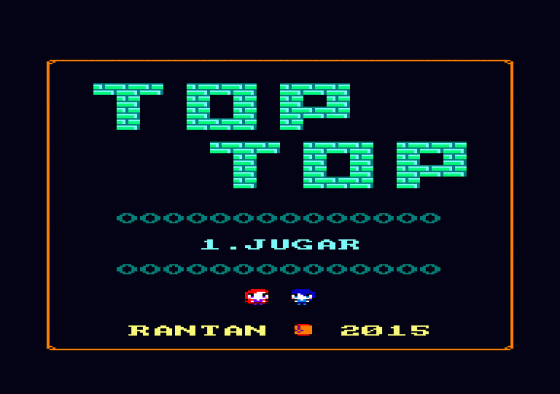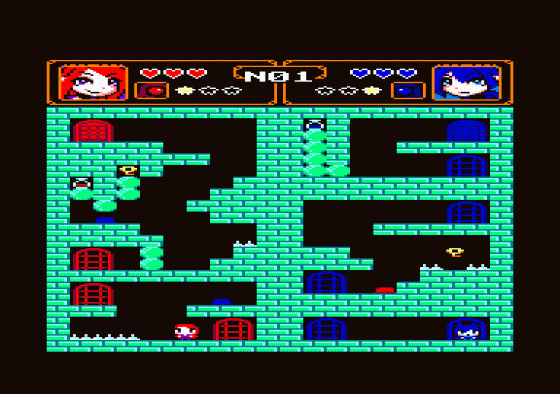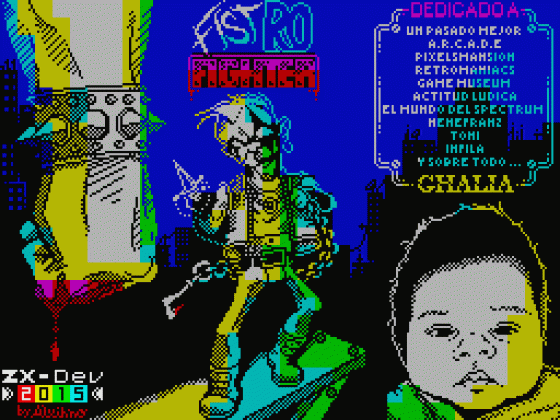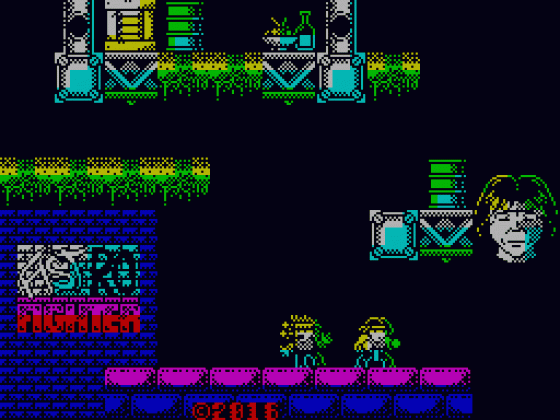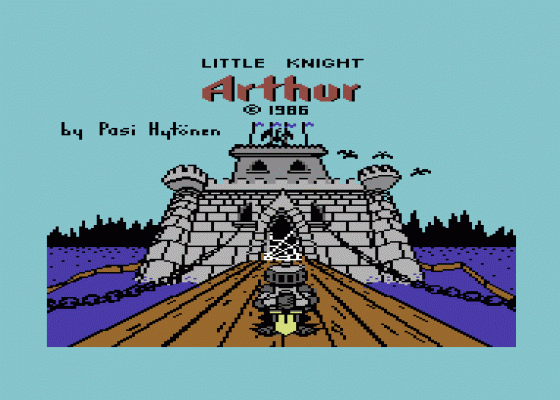
Micro Mart
 28th January 2016
28th January 2016
Dave Edwards surveys the best of the homebrew scene for the Commodore 64, Amstrad, Spectrum and Vic-20
Retro Round Up
This month, Dave E turns his attention to some of the platform games that have recently appeared for retro computers and finds the best - and worst - that the homebrew community has to offer
Welcome to Retro Round Up, our monthly look at some of the new games written for machines originally marketed over 30 years ago. As usual, the tinyurls for each will take you to Everygamegoing.com, which regular readers have now seen develop alongside this column, and now includes information on every game we've ever covered in this column (and about 74,000 others!).
This month we're focusing on new, free, platform games on the Amstrad, Spectrum and Commodore 64. So let's check out what's worth checking out...
Top Top
Amstrad owners/fans are probably as well catered for these days as Spectrum ones but, as far as I know, Spectrum games creators don't have the chance to win 900 Euros for indulging their creativity. The now annual CPCRetroDev, however, gives Amstrad coders that very chance – and last year, no less than 36 new Amstrad games competed for the cash and the winner's trophy.
Top Top by Rantan Games eventually charted third, which means the judges rated it better than 33 other games. For a Public Domain release, it comes with some slick production too – a nice anime-style cover showing its protagonists Eira and Elric battling up a castle wall.
As you can see, it looks trendy; indicating a kind of grown-up version of classic co-operative platformer Rodland. And, though the game itself lacks the cartoon-like quality of the cover art, the character design is not too shabby either. There's a nice overhead score bar showing how many lives Eira and Elric each have, the level reached and some other information.
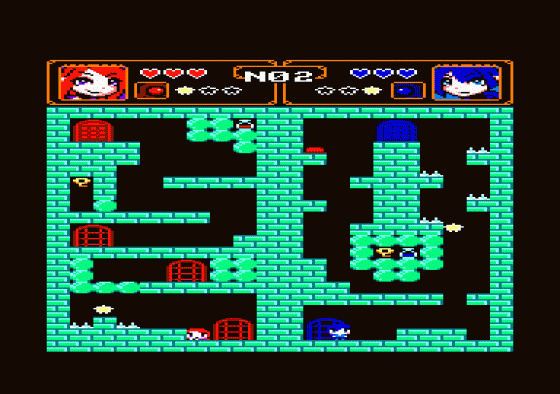
The game itself is in the Spanish language - there's no English version of it available! - and it starts with an opening screen stating “1. Jugar” which seems to mean “Press 1 to play”. Now that isn't a problem per se, but it leads me into a criticism I have made of the CPCRetroDev contest elsewhere and several times previously. Top Top is one of 36 (!) games that teams have sweated over to produce for Amstrad fans and, I assume, when it was submitted to the contest, it came with some playing instructions. CPCRetroDev judge the entries and then make the games free to download (Hoorah!) but the downloads consist of the emulator image with no playing instructions at all.
In the case of Top Top, pressing 1 indeed launches what appears to be a two player platform game, but with no instructions to refer to, I initially struggled to work out the game controls for each of them and, indeed, the premise of the game itself… In fact, even now I'm not convinced I appreciate every feature it includes. Even “1. Jugar” initially confused me as a non-Spanish speaker – I thought perhaps it meant “one-player game” and could be altered to a two-player one.
The lack of instructions really are a crying shame - Top Top has six controls per player and working them out not only took up my valuable time but also means that one almost begins the game with a sense of some frustration. There are move-combinations, for example, that are not immediately apparent; you're not sure initially whether you can shoot in more than one direction, and so on. This is also why I was rather vague when describing the score bar earlier – I'm not exactly sure of what “other information” it contains! There seems to be a box including a blob which presumably indicates the current weapon. However, since I haven't found any alternative weapons to pick up, I can't say for certain that's what it is. Like I said, the lack of instructions really are a crying shame.
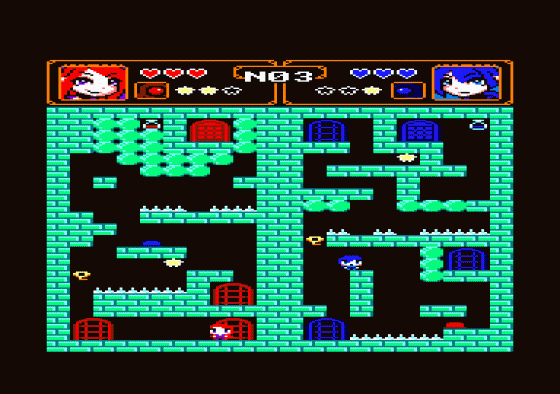
The game itself is set, as you might imagine, in a castle. Each room is divided equally in half, with Eira on the left, and Elric on the right – and each room is a co-operative puzzle. Also, as you might have reasonably deduced, the aim of the game is to get the two characters to the “top” of it. Doors litter the platforms you need to reach, and pushing the appropriate “Enter Door” control when standing in front of these performs a teleport from one door to another, “up” or “down” the room as appropriate.
All of the doors in all of the rooms start off closed. At first, that is. Either Eira or Elric will have access to a button which activates the other player's doors. Hence, each player is dependent upon the other to progress - if either player dies, there's no chance for the other to complete the room on his own. The game instead comes to a sudden end.
Despite the limited resolution of an Amstrad screen, the graphics are nice and quite colourful. Eira and Elric can run left and right, jump and crouch, and all movements are well-animated. The characters can also fire, and firing in combination with the other four game controls sends the bullet (for want of a better description!) in the expected direction. You need to shoot obstructions (invariably green round rock things) out of the way, in order to collect keys, magic potions and extra lives. However, some thought is required as to what rocks need to be blasted to oblivion, and which should remain in place so that you can walk on them to reach higher up the room. Spikes on the ground need to be avoided.
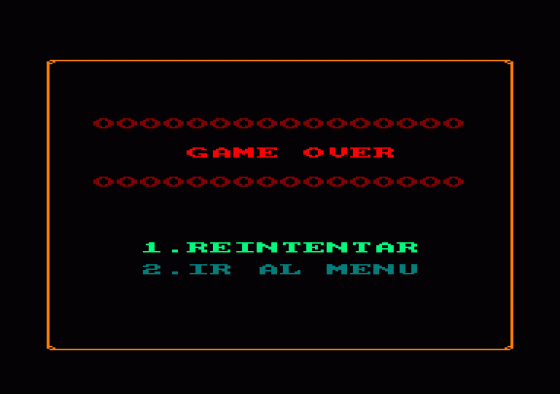
The game states that it is a co-operative two player game, and indeed, it can be played that way. However, when I grabbed a friend, we soon realised that it doesn't quite work. The problem is that the co-operation extends only to sitting on a button in “your” part of the room. No player is under threat from, say, patrolling nasties, etc, necessitating the other to “rescue” him. Instead, player one (controlling Eira) walks to a red door that he can't get through, and asks (verbally) player two (controlling Elric) to go and stand on the “red” button. Player two obliges, the red door unlocks, player one enters it, player two then walks to a blue door that he can't get through, and asks (verbally) player one to go and stand on the “blue” button. And so on. It's not really co-operative in the true sense that arcade players understand; indeed, you don't need the second player at all – you can complete every room by simply switching from the set of keys used to control Eira to the set of keys used to control Elric (and vice versa) whenever you encounter a door that you cannot pass.
Sadly, this option is not too easy because the movement controls are laid out in a different combination for each player. Player one's movement control keys ADSFG are all on the same row, whilst player two's control keys are the cursor keys plus O and P on the top row. Fiddly stuff, frequently meaning you'll inadvertently send either Eira or Elric straight to his doom when you press the wrong key and hence making this less viable an option as a direct result.
When you've worked out what to do, two players will have little difficulty in clearing the first few rooms. They get tougher as the game progresses, although they retain the same simplistic style. Even if I set aside the problems with the lack of instruction, Top Top didn't exactly bowl me over. It has good graphics, a stringy little tune accompanying the odd bleep or two that signals a particular action (game start, door opening, key collected, etc) and it moves at a fair pace. Not exceptional, and certainly not nearly in the same league as something like Rodland, but enjoyable enough for a few hours play.
Fist-Ro Fighter
In my youth (mid-80s) I bought a BBC Micro game called Subway Vigilante, a monochrome beat-'em-up contender for the worst game of all time. It was practically impossible to hit your opponent, difficult to turn around, had no music or sound, and actually defeating a bad guy involved getting in one lucky punch, retreating for about ten seconds and then repeating.
Fist-Ro Fighter is a brand new platform game for the Spectrum and is, to all intents and purposes, Subway Vigilante (with all of its flaws) infused with colour and transferred to a ladders and levels type game. You take control of one of Barcelona's top law officials and, accordingly to the daft instructions, are charged with utilising the power of "-RO! " to topple six different bad guys.
Actually, the instructions for Fist-Ro Fighter make the game seem a lot more exciting than it ultimately proves to be. They speak of a "-RO!" health bar which you can build up by hitting villains five times in a row; this will concentrate the power of your ancestors in your fist and allow you to make short work of later attackers. But to say that actually being able to do this is hit and miss is to be exceedingly generous...

It's not often that I read the instructions, start a game and end up being clobbered by the very first fighter over and over again for more than 15 minutes. However, that's what happened here. Indeed, the whole experience was so vexing that I was on the verge of reviewing it with "Fist-Ro Fighter is unworthy of even being loaded"…
The number of sins this game commits are astronomical but let's take the most obvious.
Firstly, there are only three controls: Left, Right and Punch. There's an Up key, but that's not used in the fighting. As for the fighting itself, that consists of walking up to an adversary and throwing a punch at his face. Said adversary rarely stands still - you'll get two punches in at best before he fights back. Hence, raising the "-KO" meter by bashing him five times in quick succession can't happen; instead you must try and retreat without being hit yourself. If there were a Jump key, the game mechanics would change, and you might feasibly be able to escape. But there isn't, so you're stuck with running away from him, whilst he chases you Benny Hill style.

Your sprite, and that of your opponents are very similar - same size, same colours - so it's very easy to lose track of who's who. It's also difficult to turn around, the computer seems to only be able to cope with a direction key or punch. Add to this that you must play the game in a very cramped playing area. You can't move from screen to screen freely; you must complete them in a strict sequence. Failure sends you all the way back to the beginning.
After copying the techniques in FunkySpectrum's YouTube video of the game, I did manage to progress to the second screen and, after another ten minutes of frantically running left and right with the odd punch, I beat up two more adversaries and could proceed to screen three. I walked into it and found I was now standing on some spikes and was instantly killed. At this point I decided life was too short.
I would go so far as to say that Fist-Ro Fighter is virtually unplayable. Any "progress" I made was entirely due to the fact that more energy-giving bowls of rice appeared in some games than others. It is actually worse than Subway Vigilante, which means that it would make it onto my list of the worst games I've ever played. And if you're thinking perhaps it might make up for its flaws with superb sound and music, you'd be wrong. There are none.
The only thing I found nice was the animated expressions of the Dragonball Z clone on the right of the screen.
Sorry, Retrobytes, you'll have to do a lot better than this.
Little Knight Arthur
Finnish developer Pasi Hytonen has recently uncovered (and made available) his long-lost C64 platformer Little Knight Arthur (http://www.pasisbitstuff.net/). He has also, rather thoughtfully, made available Little Knight Arthur (Cheat Version). Neither is, alas, much to write home about.
The idea of the game is to navigate little knight Arthur around a succession of seven caverns. The mission for each cavern varies from simply making it through the room in one piece to rescuing one of your kidnapped comrades by taking an item in one part of the cavern to another.
The overall layout of the game is fairly pleasing, with some basic sprites set against a black background. There is also music on interrupt which is reasonably tuneful. Little Knight Arthur also reacts instantly to joystick or keyboard movement.

Unfortunately, however, the game is one of almost complete randomness - the spiders, rivers, bats and crab-bat things that inhabit each room don't follow any set pattern. This makes the game nigh on infuriating, as you need both pixel-perfect positioning and for the Gods of Retrogaming to move your adversary in exactly the right direction at exactly the right time (and keep him moving in that direction throughout your jump over him).
This is just too ridiculous; it doesn't even allow for any kind of increasing difficulty as you venture further into the game. From the very start, it's just ridiculously unfair. More irritatingly still, the third cavern - if you ever get that far! - is not quite as random as the first or second. Put this cavern first and players might be at least encouraged for a while…!
This game was written in 1985, which is when the Commodore 64 was coming of age. Nevertheless, in that era of Beach Head and Crystal Castles, it's difficult to imagine Little Knight Arthur would have competed well. At best, it would've been a budget title. This is more or less acknowledged by the author himself, who seems to have released the Cheat Version almost entirely to counter that criticism.
The Cheat Version includes an intro "trainer" where all manner of cheats (infinite lives, invulnerability, always have sword, etc) may be enabled, allowing you to at least see the later caverns. I've never been a big fan of such options and here they seem to be an admission that few will get far will the original version.
Do I recommend you download and play either of them? What do you think?
Seto Taisho Vs. Yokai
Alessandro Grussu has done it again! Largely known for bringing us the Spectrum games Funky Fungus and Cousin Horace, he's now released Seto Taisho Vs Yokai. And what a unique, barking madcap piece it is! You're tasked with beating, amongst others, the Bura-Bura lanterns, the Kara-Kasa all-seeing triangles and what look like huge pairs on breasts on legs. Thank goodness for the Vs in that title, eh? Otherwise, this would all be nonsense.
I've seen few new Spectrum games released in so many versions as this. Quite apart from its premise - which I'll get to in a second - and the amount of research that has gone into its creation, it seems the entire ZX community has got behind this project. It's available with English, Italian, Portuguese, German and Spanish instructions and, if a certain key combination is hit, you'll find the opening screen later rendered in Japanese too.
Like all the greats, the game itself is amazingly simple and is a little like Pang. Pang is (in case you don't know) an oft-forgotten classic whereby a number of spheres bounce around the screen and must be blasted. Seto Taisho effortlessly moves this concept to a platform environment, and replaces the spheres with Japanese monsters and goblins, aka the Yokai. A Spectrum 128K only game, Grussu utilises all of that extra memory to pack in fourteen Yokais and three background symphonies; all of which perfectly complement the action. Indeed, the jangling Eastern tunes have a charm all of their own.

So, what do you actually do? Well, as if it needed saying, you keep well out of range of the bouncing Yokai and run left and right, jutting out the spear you carry at right angles. A prick of the spear on any Yokai will give a satisfying puncture sound, and may cause it to reverse direction. You then run or jump after it, and prick it until it explodes in a cloud of smoke. When you've cleared the screen of Yokais, "GANBARE!" (Go On! in Japanese) appears in the centre of the screen and you proceed to the next room. Different Yokais require different strategies but none are so obscure that they can't be worked out with reference to the inlay card and a bit of applied common sense.
I don't have anything negative to say about Seto Taisho Vs Yokai; it's very responsive, gorgeous to look at and has easily taken a team the best part of two years to produce. It would be easily worth the average £4.99 price tag of a new Spectrum game. The icing on the cake has to be, therefore, that it's being given away completely for free.
The tragedy of this is simply that it doesn't have a lot of exposure; I literally just stumbled across it on a World Of Spectrum forum post. Hopefully this review will remedy that situation somewhat, because this is one that, once you've played it once, you'll definitely be coming back to.
That's All Folks!
Regular readers will remember that this column used to contain a Soapbox and, considering recent (and rather dubious) Kickstarter events (of which retro fans are probably well aware), this month it very nearly made a return. Not for the first time, all things retro were tarnished by the activities of alleged cowboys, and it has left some with a bitter taste in their mouths.
However, as I've said before, the Retro Round Up is primarily a software round up; it is a place where those who have produced games for the retro formats can see their work criticised. I even don't give column space to Works In Progress, only to completed games. The Coleco Chameleon is a good illustration of why; sometimes even paying passing regard to a potential new retro machine could be interpreted as an endorsement.
See you next month!
Scores
(Spectrum 48K)
(Commodore 64)
(Commodore 64)
(Spectrum 128K)
(Spectrum 128K)
(Amstrad CPC464)

